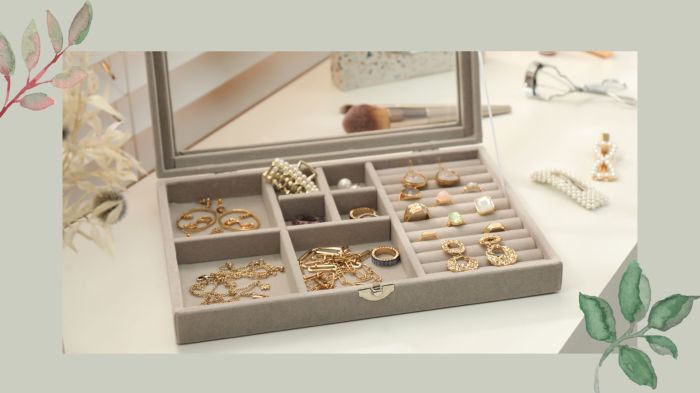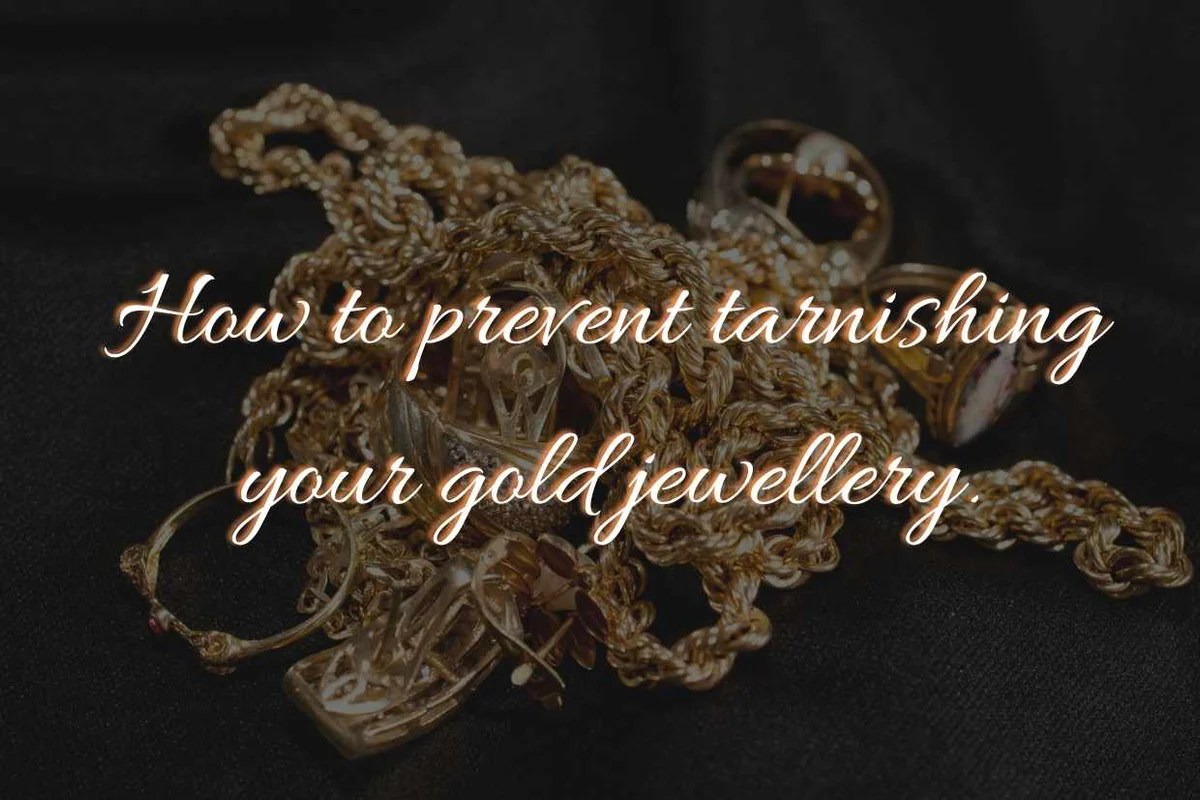Best ways to store jewelry to prevent tarnishing? It’s way more than just tossing your bling into a drawer! Seriously, knowing how to properly store your necklaces, rings, and earrings can be the difference between sparkling treasures and dull disappointments. We’re diving into the science of tarnish – what causes it, which metals are most vulnerable, and, most importantly, how to keep your jewelry looking its absolute best.
Get ready to become a jewelry storage pro!
This guide covers everything from the best containers and materials to environmental factors that can accelerate tarnishing. We’ll explore different storage methods for various types of jewelry, from delicate necklaces to chunky statement pieces. Plus, we’ll share some super easy cleaning tips to keep your collection shining bright. Think of it as your ultimate guide to keeping your favorite pieces looking fabulous for years to come.
Understanding Tarnish
Tarnish is a bummer, right? You pull out your favorite necklace, and it’s dull and discolored. Understanding the science behind tarnish helps you prevent it and keep your jewelry looking its best. Basically, it’s a chemical reaction that happens when metals react with their environment.Tarnish Formation: Factors and ProcessesTarnish is essentially a thin layer of corrosion that forms on the surface of certain metals.
This process is primarily driven by oxidation, a chemical reaction where a metal loses electrons to oxygen in the air. Think of it like a slow, chemical rust. However, it’s not just oxygen that’s involved; humidity plays a significant role, accelerating the oxidation process. Higher humidity levels create a more conducive environment for the reaction to occur.
Furthermore, exposure to various chemicals, such as sulfur compounds found in air pollution or even in certain foods, can significantly speed up the tarnishing process. These sulfur compounds react with metals to form sulfides, which are often darker and more noticeable than oxides.Common Metals and Their Tarnishing VulnerabilitiesSeveral metals are particularly susceptible to tarnishing. Silver, for example, readily reacts with sulfur compounds in the air to form silver sulfide, resulting in that characteristic dark, almost black tarnish.
Copper also tarnishes easily, forming a green patina (copper carbonate) over time, especially in humid environments. Gold, while famously resistant, isn’t completely immune; it can tarnish slightly under certain conditions, though this is usually less noticeable than with other metals.
Metal Tarnish Susceptibility
| Metal Type | Tarnish Rate | Prevention Methods |
|---|---|---|
| Silver | High (especially with sulfur exposure) | Airtight storage, anti-tarnish cloths, silica gel packets |
| Copper | Medium to High (dependent on humidity and pollutants) | Regular polishing, protective coatings, airtight storage |
| Gold | Low (generally requires significant exposure to harsh chemicals) | Regular cleaning, avoiding exposure to harsh chemicals |
| Platinum | Very Low (highly resistant to tarnish) | Regular cleaning, gentle handling |
Proper Storage Methods

So, you understand why tarnish happens. Now, let’s talk about how to keep your bling looking its best – proper storage is key! Choosing the right containers and materials is crucial in preventing your precious metals from reacting with the environment and losing their luster. Think of it like this: your jewelry needs a spa day, and we’re going to find the perfect accommodations.Proper storage significantly impacts the longevity and appearance of your jewelry.
The right container and materials act as a protective barrier, shielding your pieces from air, moisture, and other environmental factors that contribute to tarnish. Using unsuitable materials can actually accelerate the tarnishing process, negating all your efforts to keep your jewelry sparkling.
Jewelry Storage Containers
Different jewelry pieces require different levels of protection. A delicate necklace needs a more gentle approach than a sturdy pair of earrings. Jewelry boxes, pouches, and cases all offer varying degrees of protection and organization. Jewelry boxes, for example, often provide individual compartments for different pieces, preventing scratching and tangling. Pouches are great for travel and offer a soft, protective layer, while cases are typically more rigid and ideal for protecting more valuable pieces.
The best choice depends on your jewelry collection and your storage needs.
Storage Materials and Their Impact on Tarnish Prevention
The material of your storage container plays a significant role in preventing tarnish. Some materials are better suited than others for protecting jewelry from the elements. Velvet, for instance, is a popular choice due to its soft texture and ability to cushion jewelry, preventing scratches. However, certain fabrics, especially those made with synthetic materials or dyes, can potentially react with metals and cause discoloration.
Plastic, while convenient and inexpensive, isn’t always the best option, as some plastics can release chemicals that accelerate tarnish. The key is to use acid-free and inert materials that won’t interact chemically with your jewelry.
Ideal Storage Materials
Choosing the right materials is crucial for long-term preservation. Here’s a breakdown of some popular options:
- Acid-Free Tissue Paper: Advantage: Soft, protective, and readily available. Disadvantage: Can be easily torn and requires careful handling.
- Velvet-Lined Boxes: Advantage: Luxurious, protective, and prevents scratching. Disadvantage: Can be more expensive and may not be suitable for all metals.
- Soft, Natural Fabrics (e.g., cotton, linen): Advantage: Breathable and gentle on jewelry. Disadvantage: May not offer as much protection as velvet or specialized materials.
- Acid-Free Cardboard Boxes: Advantage: Affordable and readily available. Disadvantage: Not as protective as other options and may require additional padding.
- Plastic (Avoid): Advantage: Inexpensive and widely available. Disadvantage: Can release chemicals that react with metals and accelerate tarnish. Choose only high-quality, acid-free plastics if absolutely necessary.
Environmental Control
Keeping your jewelry sparkling involves more than just proper storage containers; it’s about controlling the environment surrounding your precious pieces. Air quality, humidity levels, and temperature fluctuations all play a significant role in how quickly your jewelry tarnishes. Understanding these factors is key to preserving your collection’s beauty.Air exposure, humidity, and temperature all significantly impact the rate of tarnishing.
Exposure to air introduces oxygen and various pollutants that can react with metals, leading to oxidation and discoloration. High humidity provides an ideal environment for the formation of sulfides, which are a primary cause of tarnish. Similarly, fluctuating temperatures can accelerate chemical reactions that contribute to tarnishing. Consistent environmental conditions are much gentler on your jewelry.
Effects of Air Exposure, Humidity, and Temperature on Jewelry Tarnish
Airborne pollutants, such as sulfur compounds from industrial emissions or even cooking, readily react with silver and other reactive metals. High humidity levels create a moist environment that facilitates chemical reactions, accelerating the formation of tarnish. Temperature fluctuations cause expansion and contraction of metals, potentially disrupting protective coatings and making them more susceptible to environmental attack. For example, a silver bracelet stored in a consistently cool, dry environment will tarnish significantly slower than one left in a humid, fluctuating-temperature bathroom.
Guidelines for Maintaining a Suitable Storage Environment
Maintaining a stable environment is crucial for preventing tarnish. Optimal storage conditions include a cool, dry, and dark space with minimal air circulation. Airtight containers further protect jewelry from exposure to pollutants and fluctuating humidity. Consider using silica gel packets within storage containers to absorb excess moisture. Regularly inspecting your jewelry and cleaning it gently when necessary will help maintain its shine.
Remember, consistent conditions are key; drastic changes in temperature or humidity can dramatically increase tarnish.
Flowchart for Creating an Optimal Jewelry Storage Environment
The following steps Artikel the process of creating an optimal storage environment:[Imagine a flowchart here. The flowchart would begin with a box labeled “Assess Current Environment.” Arrows would lead to boxes representing steps like “Identify Sources of Humidity,” “Measure Temperature and Humidity,” “Select Appropriate Storage Containers,” “Implement Airtight Seals,” “Use Desiccants (Silica Gel),” and “Regularly Monitor and Adjust.” The final box would be “Optimal Storage Environment Achieved.”]
Environmental Factors Accelerating Tarnish and Mitigation Strategies
Maintaining a consistent environment is vital for slowing down the tarnishing process. Below is a list of factors that accelerate tarnishing and ways to mitigate their effects:
- High Humidity: Use airtight containers and silica gel packets to absorb moisture. Store jewelry in a climate-controlled area if possible.
- Air Pollutants: Store jewelry in airtight containers in a clean, well-ventilated area, away from sources of sulfur compounds (e.g., industrial areas, kitchens).
- Fluctuating Temperatures: Store jewelry in a location with consistent temperature. Avoid areas subject to significant temperature swings.
- Direct Sunlight: UV rays can damage some jewelry materials; store jewelry in a dark or dimly lit area.
- Contact with Other Metals: Store dissimilar metals separately to prevent galvanic corrosion. For example, keep your silver jewelry away from your gold jewelry.
Individual Jewelry Care: Best Ways To Store Jewelry To Prevent Tarnishing
Knowing how to care for your jewelry isn’t just about keeping it looking shiny; it’s about preserving its value and extending its lifespan. Different materials require different approaches, and understanding these nuances is key to preventing damage and tarnish. This section will detail specific care instructions for various metals and gemstones, ensuring your precious pieces stay beautiful for years to come.
Specific Metal and Stone Care Recommendations
Proper storage and cleaning techniques vary significantly depending on the material. Ignoring these differences can lead to irreversible damage or dullness. For example, leaving silver jewelry in a humid environment will accelerate tarnishing, while exposing pearls to harsh chemicals can damage their delicate surfaces. Understanding these individual needs is crucial for maintaining the beauty and integrity of your collection.
Storage and Cleaning Guide for Various Jewelry Types, Best ways to store jewelry to prevent tarnishing
| Material | Storage Method | Cleaning Techniques |
|---|---|---|
| Silver | Airtight containers or pouches lined with anti-tarnish fabric; keep away from moisture. | Use a silver polishing cloth or a mild jewelry cleaner specifically designed for silver. |
| Gold | Soft-lined jewelry boxes or pouches; can generally tolerate more exposure to air than silver. | Warm soapy water and a soft cloth are usually sufficient; avoid harsh chemicals. |
| Pearls | Soft fabric-lined boxes, stored separately from other jewelry to avoid scratching; avoid direct sunlight and humidity. | Wipe gently with a soft, damp cloth after each wearing; avoid harsh chemicals and ultrasonic cleaners. |
| Gemstones (e.g., diamonds, sapphires, rubies) | Soft-lined boxes or pouches; store separately to prevent scratching. | Warm soapy water and a soft brush can be used; avoid abrasive cleaners. Professional cleaning is recommended periodically. |
Storing a Delicate Necklace
To properly store a delicate necklace and prevent tangles and scratches, imagine a soft, velvet-lined jewelry box or a small, zippered pouch. The necklace should be carefully laid flat within the container. If the necklace has a clasp, fasten it securely before placing it in storage. Avoid stacking necklaces on top of each other, as this can lead to scratching and knotting.
For particularly long or intricate necklaces, consider using a necklace roll or a specialized jewelry organizer with individual compartments to keep each piece separate and prevent tangles. This method ensures that the necklace remains protected and its delicate design is preserved.
Cleaning and Maintenance
Keeping your jewelry sparkling requires more than just proper storage; regular cleaning is crucial for preventing and removing tarnish. This involves understanding safe and effective cleaning methods, choosing the right products, and knowing when to seek professional help. Ignoring tarnish can lead to irreversible damage, so a proactive approach is key.
Safe and Effective Jewelry Cleaning Methods
Several methods exist for cleaning tarnished jewelry, ranging from simple home remedies to professional services. The best approach depends on the type of metal and the severity of the tarnish. Gentle methods are always preferred to avoid scratching or damaging delicate pieces. For heavily tarnished items, professional cleaning might be necessary to ensure thorough and safe cleaning.
Homemade Jewelry Cleaning Solutions
Creating your own jewelry cleaning solutions can be cost-effective and environmentally friendly. However, it’s crucial to choose ingredients appropriate for the metal type. Never use harsh chemicals or abrasive materials that could scratch or damage your jewelry.
Baking Soda Paste
A simple paste of baking soda and water is effective for cleaning many types of metal jewelry. Mix equal parts baking soda and water to create a thick paste. Gently rub the paste onto the tarnished areas using a soft cloth or toothbrush. Rinse thoroughly with warm water and dry immediately with a soft, lint-free cloth. This method is particularly effective for silver and some gold pieces.
White Vinegar and Baking Soda Soak
For more stubborn tarnish, a soak in a solution of white vinegar and baking soda can be effective. In a glass bowl, combine 1/2 cup white vinegar and 1 tablespoon baking soda. Allow the solution to fizz slightly before gently submerging your jewelry. Soak for 15-30 minutes, monitoring regularly. Remove the jewelry, rinse thoroughly, and dry immediately.
This method should be used cautiously and not on all metals.
Commercial Jewelry Cleaning Products and Associated Risks
Commercial jewelry cleaning products offer convenience but often contain harsh chemicals that can damage certain metals or gemstones. Always read the product label carefully and follow instructions precisely. Some products may be abrasive, potentially scratching the surface of your jewelry. Furthermore, some commercial solutions might contain chemicals that could react negatively with certain metals, leading to further damage or discoloration.
Always test a small, inconspicuous area first before applying the cleaner to the entire piece.
Cleaning a Silver Necklace: A Step-by-Step Guide
This example demonstrates cleaning a silver necklace using the baking soda paste method. Remember to always prioritize gentle handling to avoid scratching.
Materials:
- Silver necklace
- Baking soda
- Water
- Soft cloth
- Soft-bristled toothbrush (optional)
- Bowl of warm water
- Lint-free cloth
Procedure:
- Prepare the baking soda paste: Mix equal parts baking soda and water to create a smooth paste.
- Apply the paste: Gently apply the paste to the tarnished areas of the necklace using a soft cloth or toothbrush. Avoid scrubbing vigorously.
- Rinse: Rinse the necklace thoroughly under warm running water.
- Dry: Gently dry the necklace with a lint-free cloth. Avoid rubbing too hard.
- Inspect: Inspect the necklace for any remaining tarnish. Repeat the process if necessary.
Remember to always handle your jewelry with care and avoid using abrasive materials. If you are unsure about cleaning a particular piece, it is best to consult a professional jeweler.
Outcome Summary

So, there you have it – your crash course in keeping your jewelry looking its best! By understanding the causes of tarnish and implementing these simple storage and cleaning techniques, you can significantly extend the life and beauty of your precious pieces. Remember, a little preventative care goes a long way. Now go forth and shine (and keep your jewelry shining too!).
Popular Questions
Can I store different metals together?
It’s generally best to store similar metals together. Some metals can react with each other, leading to tarnish or scratches.
How often should I clean my jewelry?
It depends on how often you wear it and the type of metal. A good rule of thumb is to clean it every few months or whenever it starts to look dull.
What should I do if my jewelry is already tarnished?
Don’t panic! There are many safe and effective ways to clean tarnished jewelry. Check out the cleaning section of this guide for some helpful tips.
Is it okay to use commercial jewelry cleaners?
Commercial cleaners can be effective, but some can be harsh and damage certain metals or stones. Always check the label carefully and test it on a small, inconspicuous area first.
